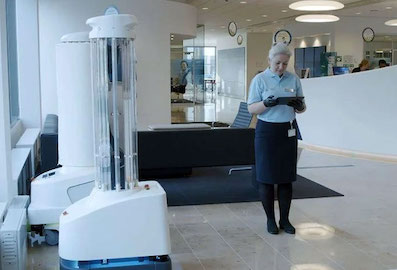 Cleanzine: your weekly cleaning and hygiene industry newsletter 26th June 2025 Issue no. 1168
Cleanzine: your weekly cleaning and hygiene industry newsletter 26th June 2025 Issue no. 1168
Your industry news - first
The original and best - for over 20 years!
We strongly recommend viewing Cleanzine full size in your web browser. Click our masthead above to visit our website version.
Better-than-national infection rate drops even further at hospital using Xenex
 In America's hospitals, approximately one in 20 patients will contract a hospital-acquired infection. At Cooley Dickinson Hospital last year, one in 129 patients got an HAI. Now, those better odds of avoiding an infection at Cooley Dickinson have improved even further, as the hospital has documented a groundbreaking 82% drop in one type of infection, Clostridium difficile.
In America's hospitals, approximately one in 20 patients will contract a hospital-acquired infection. At Cooley Dickinson Hospital last year, one in 129 patients got an HAI. Now, those better odds of avoiding an infection at Cooley Dickinson have improved even further, as the hospital has documented a groundbreaking 82% drop in one type of infection, Clostridium difficile.
"This decrease translates to many more people leaving the hospital safer and with better outcomes," says Joanne Levin, MD, CDH's Medical Director of Infection Prevention.
The 82% drop in incidence of C. diff occurred following adoption in January of room cleaning with portable UV light, an added step among many CDH already takes to eliminate infections, reports Joanne. Cooley Dickinson Hospital was the first hospital in the Northeast to use the Xenex PX-UV Disinfection System.
"The work of CDH staff to keep patients far safer than other hospitals is terrific, but two C. diff infections is still two too many," argues President/CEO Craig Melin, whilst applauding the efforts of hospital staff, particularly environmental services and nursing team members, to accommodate the additional step of UV disinfection.
"Cooley Dickinson's extra efforts mean the chances of getting an infection in this hospital are significantly less than 1%, compared to a 5% risk in general in the nation."
According to Joanne, the dramatic decrease in C. diff transmission occurred during the time when most of the patient rooms and bathrooms were disinfected with the UV light.
Cooley Dickinson had a strong infection prevention programme in place before adding the UV disinfection, and the programme - which includes best-practice room cleaning and proper hand hygiene - was already lowering infection rates, explains Joanne. But a bug like C. diff requires a stronger weapon than the tools that had been in place at the hospital.
Specific rates of C. diff infections are not available, but the Centers for Disease Control and Prevention (CDC) tracked a nearly twofold increase in C. diff infections from 1996 to 2003. Two statewide studies in Oregon and Massachusetts found C. diff infections increasing at an even faster pace.
The C. diff germ can be found in the community and can be transmitted when a patient is in any care facility, including a hospital or a nursing home.
What makes C. diff especially virulent is that the organism can make spores, which are like seeds with a hard shell. Even strong hospital cleaning products can't penetrate the shell, explains Joanne. Subsequently, C. diff can live in an environment for months. In one study, C. diff disease was found on 49% of surfaces in hospital rooms housing a patient with the infection and on 29% of surfaces in rooms with a patient who carries the germ but has no symptoms, according to a March 2011 report in Infection Control & Hospital Epidemiology.
UV light has long been used as a hospital disinfectant, starting in the 1950s when it was used to clean the air in TB wards. Joanne says the light fell out of favour over the years due to maintenance and cost concerns. Brian Cruver, CEO of Xenex, says that other room disinfection technologies have been in use for several years but have been unable to produce successful patient outcome data. Cooley Dickinson Hospital's results "offer proof to hospitals of what our unique pulsed-xenon technology can do," he argues.
According to Xenex, its UV disinfection system has consistently shown to be more than 20 times more effective against C. diff and other superbugs than standard cleaning practices alone. The Xenex system quickly kills microorganisms on surfaces and in the air without contact or additional chemicals. The UV light penetrates the cell walls of the germ - fusing their DNA together - leading to instant damage, the inability to reproduce or mutate and killing the organism.
According to the CDC, HAIs are the fourth leading cause of death in the United States. Cooley Dickinson has implemented all the standard recommendations - and then some - to keep patients safe from the spread of HAIs, including C. diff disease, Methicillin-resistant Staphylococcus aureus (MRSA), another infection that the CDC considers a public health threat, as well as 11 others.
"We are striving to eliminate the transmission of infections through a combination of best cleaning practices, hand hygiene, surveillance and technology, such as the hospital-wide use of UV room disinfection," adds Joanne. "We are more aggressively implementing these practices and our effort is paying off for our patients."
Cooley Dickinson, a full-service community hospital, is ranked in the top 5% of all US hospitals in patient safety by HealthGrades, the country's leading independent health care ratings organisation. Cooley Dickinson's staff of 1,650 professionals and nearly 400 affiliated physicians comprise a network of emergency, surgical, clinical, rehabilitative, hospice and home care expertise that treats 40,000 emergency patients per year, delivers 800 babies, and collaborates with Massachusetts General Hospital to deliver comprehensive cancer care.
T: (413) 582-2421
E: [email protected]
W: www.cooley-dickinson.org
T: (210) 824-3433
E: [email protected]
W: www.xenex.com
2nd February 2012







